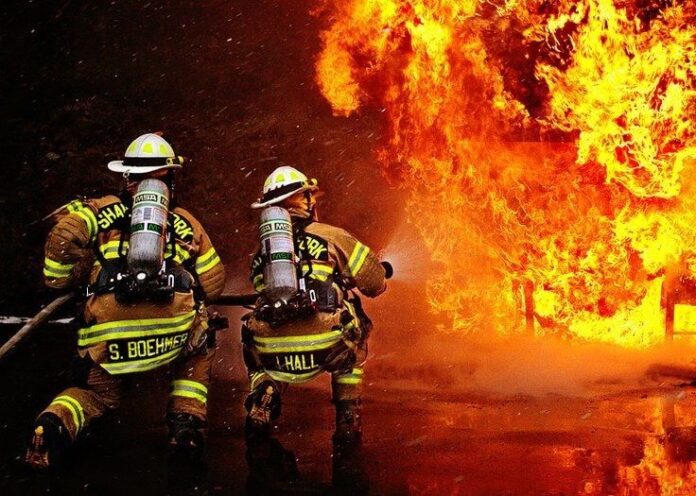 The Virginia Department of Fire Programs announced today that Virginia has seen an increase in civilian fire fatalities during the first quarter of 2018. As of May 29, the Commonwealth experienced 39 fire fatalities, about one civilian killed by fire in Virginia every four days. This equates to an increase of 40 percent from this date in calendar year 2017 when there were 28 fire fatalities.
The Virginia Department of Fire Programs announced today that Virginia has seen an increase in civilian fire fatalities during the first quarter of 2018. As of May 29, the Commonwealth experienced 39 fire fatalities, about one civilian killed by fire in Virginia every four days. This equates to an increase of 40 percent from this date in calendar year 2017 when there were 28 fire fatalities.
While the State Fire Marshal’s Office continues to analyze the data, the preliminary results indicate that most fatal fires in Virginia were caused by human factors. Careless smoking and improperly discarded smoking materials remain the leading cause of fatal fires in Virginia for 2018. Other identified causes include portable heating equipment, unattended cooking and electrical issues. The median age of the victims is 70 years old. Many of the victims had mobility issues that prevent timely evacuation from the residence.
“The best way to fight fires is to prevent them from ever starting,” said Chief Michael Reilly, Executive Director of the Virginia Department of Fire Programs. “We need to be mindful of the fire risks within our homes. Together we can prevent unnecessary loss of life and property due to fire by having working smoke alarms, practicing home escape plans and practicing fire prevention efforts every day.”
Fires in homes today burn hotter and faster due to synthetic furnishings and lightweight construction materials. As a result, occupants have a much smaller window of time to exit safely. You have as little as two minutes from the time the smoke alarm sounds before the smoke spreads throughout the home. Smoke inhalation is the cause of most fire deaths, not burns.
“While a smoke alarm can alert you to the fire danger within your home, it does nothing to slow or stop fire spread,” said Brian McGraw, Virginia State Fire Marshal. “Our data indicates that older adults are more likely to die in a fire because they lack the ability to exit quickly. However, residential sprinklers contain or extinguish fires while they are still small and reduce the risk of dying in a home fire by nearly 80 percent.”
The Virginia Department of Fire Programs took part in a North America-wide campaign on May 19, 2018, to raise awareness of the growing dangers of home fires and the life-saving benefits of installing fire sprinklers in new homes. Initiated by the National Fire Protection Association (NFPA) and the Home Fire Sprinkler Coalition (HFSC), Home Fire Sprinkler Day provides an opportunity for everyone in Virginia to learn about new-home dangers, get the facts about lifesaving sprinkler technology and make progress against the home fire problem.
“The purpose is to organize a unified day of action on May 19 with a focus on the tough problem of home fires and the equally tough protection of home fire sprinkler technology,” says Lorraine Carli, Vice President at NFPA and President of HFSC. “By joining forces coast to coast, communities are debunking persistent myths, helping consumers learn the facts before they build or buy a new home, and urging their local officials to support sprinkler codes.”
The Virginia State Fire Marshal’s Office continues to work closely with its Federal, state and local partners to help address the human factors linked to a significant majority of fire casualties. We encourage all Virginians to practice fire safety within their home.
Keep the following safety messages in mind:
- Smoke outside. Modern construction materials and synthetic furnishings are creating home fires that burn faster than ever.
- Never smoke near or while using medical oxygen.
- Put cigarettes out all the way. Do not discard cigarettes in combustible ground cover such as mulch, potted plants or dry grass.
- Make sure that smoke alarms are installed and operational in every sleeping room and outside any sleeping areas.
- Develop and practice a fire escape plan at least twice a year. A home fire escape plan should include two exits from every room, a path to the outside from each exit, smoke alarms in all required locations and a meeting place outside where everyone will meet upon exiting.
- Keep your exit routes clear of obstructions that could slow your evacuations.
- Don’t leave individuals that are not capable of self-evacuation alone.
- Once you get outside, stay outside. Leave the rescue efforts to our valiant firefighters.
FOR MORE INFORMATION GO TO:House Fires: Prevention, Preparation, and Other Safety Considerations


